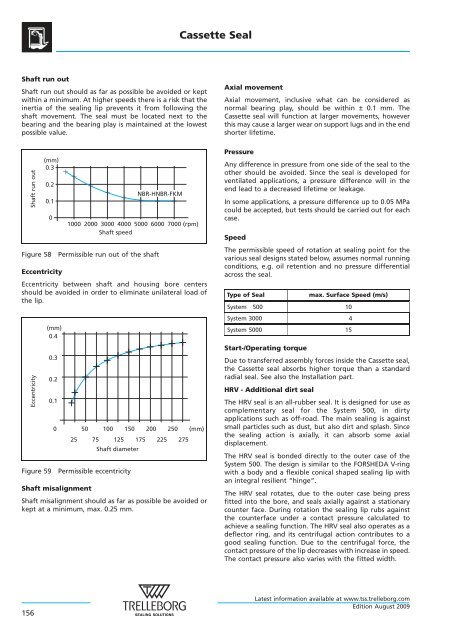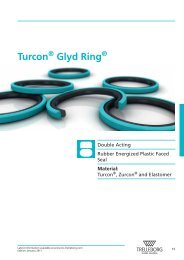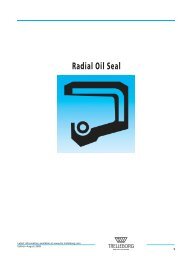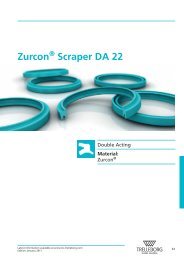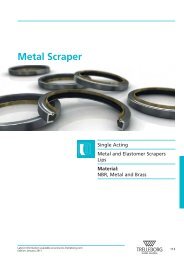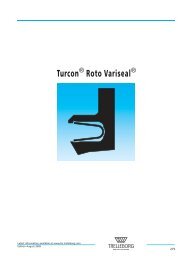Rotary Seal
Rotary Seal
Rotary Seal
Create successful ePaper yourself
Turn your PDF publications into a flip-book with our unique Google optimized e-Paper software.
Cassette <strong>Seal</strong><br />
Shaft run out<br />
Shaft run out should as far as possible be avoided or kept<br />
within a minimum. At higher speeds there is a risk that the<br />
inertia of the sealing lip prevents it from following the<br />
shaft movement. The seal must be located next to the<br />
bearing and the bearing play is maintained at the lowest<br />
possible value.<br />
Axial movement<br />
Axial movement, inclusive what can be considered as<br />
normal bearing play, should be within ± 0.1 mm. The<br />
Cassette seal will function at larger movements, however<br />
this may cause a larger wear on support lugs and in the end<br />
shorter lifetime.<br />
Shaft run out<br />
(mm)<br />
0.3<br />
0.2<br />
0.1<br />
0<br />
Figure 58<br />
NBR-HNBR-FKM<br />
1000 2000 3000 4000 5000 6000 7000 (rpm)<br />
Shaft speed<br />
Permissible run out of the shaft<br />
Eccentricity<br />
Eccentricity between shaft and housing bore centers<br />
should be avoided in order to eliminate unilateral load of<br />
the lip.<br />
Eccentricity<br />
Figure 59<br />
(mm)<br />
0.4<br />
0.3<br />
0.2<br />
0.1<br />
0<br />
50<br />
100 150 200 250<br />
25 75 125 175 225 275<br />
Shaft diameter<br />
Permissible eccentricity<br />
(mm)<br />
Shaft misalignment<br />
Shaft misalignment should as far as possible be avoided or<br />
kept at a minimum, max. 0.25 mm.<br />
Pressure<br />
Any difference in pressure from one side of the seal to the<br />
other should be avoided. Since the seal is developed for<br />
ventilated applications, a pressure difference will in the<br />
end lead to a decreased lifetime or leakage.<br />
In some applications, a pressure difference up to 0.05 MPa<br />
could be accepted, but tests should be carried out for each<br />
case.<br />
Speed<br />
The permissible speed of rotation at sealing point for the<br />
various seal designs stated below, assumes normal running<br />
conditions, e.g. oil retention and no pressure differential<br />
across the seal.<br />
Type of <strong>Seal</strong><br />
max. Surface Speed (m/s)<br />
System 500 10<br />
System 3000 4<br />
System 5000 15<br />
Start-/Operating torque<br />
Due to transferred assembly forces inside the Cassette seal,<br />
the Cassette seal absorbs higher torque than a standard<br />
radial seal. See also the Installation part.<br />
HRV - Additional dirt seal<br />
The HRV seal is an all-rubber seal. It is designed for use as<br />
complementary seal for the System 500, in dirty<br />
applications such as off-road. The main sealing is against<br />
small particles such as dust, but also dirt and splash. Since<br />
the sealing action is axially, it can absorb some axial<br />
displacement.<br />
The HRV seal is bonded directly to the outer case of the<br />
System 500. The design is similar to the FORSHEDA V-ring<br />
with a body and a flexible conical shaped sealing lip with<br />
an integral resilient “hinge“.<br />
The HRV seal rotates, due to the outer case being press<br />
fitted into the bore, and seals axially against a stationary<br />
counter face. During rotation the sealing lip rubs against<br />
the counterface under a contact pressure calculated to<br />
achieve a sealing function. The HRV seal also operates as a<br />
deflector ring, and its centrifugal action contributes to a<br />
good sealing function. Due to the centrifugal force, the<br />
contact pressure of the lip decreases with increase in speed.<br />
The contact pressure also varies with the fitted width.<br />
156<br />
Latest information available at www.tss.trelleborg.com<br />
Edition August 2009


